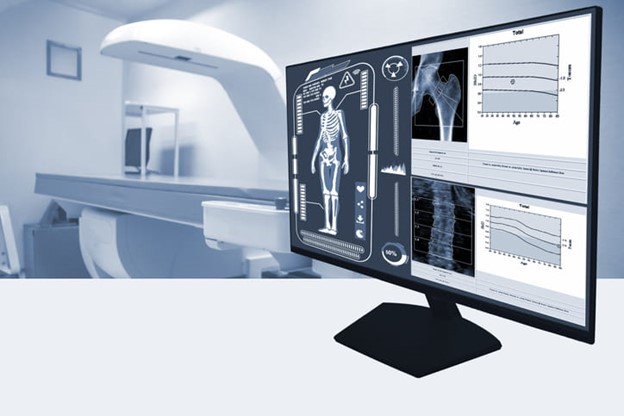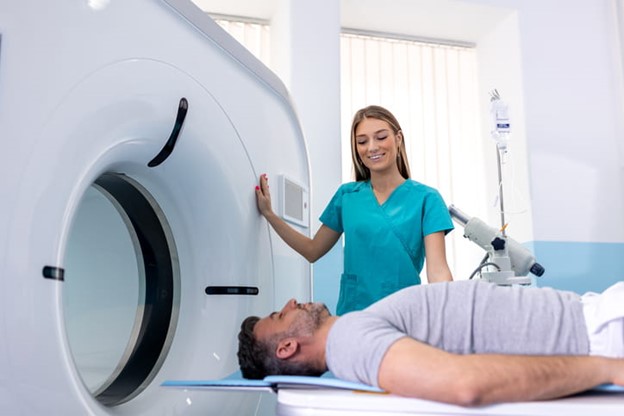
According to the Centers for Disease Control and Prevention (CDC), osteoporosis affects as many as one in five women and one in twenty men. Without a bone density scan, there is no way to be sure that you aren’t gradually developing osteoporosis. Osteoporosis makes it more likely you will break a bone. Unfortunately, as you get older, broken bones don’t always heal as well. This can lead to constant pain and even disability in some cases. Keep reading to learn more about bone density, bone density scans, and why they’re important.
What is bone density?
According to the National Institute of Arthritis and Musculoskeletal and Skin Diseases (NIH), bone density refers to the amount of calcium and other minerals in bones. The denser bones are, the more sturdy they are and the less likely they are to break.
What is a bone density scan?
According to the Mayo Clinic, a bone density scan is an X-ray that measures the amount of calcium and other minerals in your bones. It is a medical scan commonly used to determine if you have osteoporosis, whether you are beginning to show signs of it, and, if you already have it, how well your osteoporosis is being managed.
What does a bone density scan show?
A bone density scan recounts how much calcium and other minerals are present in your bones with two different numbers known as your “T-score” and your “Z-score.” The “T-score” refers to how you compare to what is normal for a healthy adult of your sex, and the “Z-score” refers to what your bone density is compared to what is considered normal for your sex, race, ethnicity, age, and height.
Are you curious about a preventative medical scan? Check out Preventative Diagnostic Center today and schedule your CT scan
Four reasons bone density scans are important
1) Because there aren’t normally symptoms in the early stages of osteoporosis
According to the NIH, there are frequently no symptoms of osteoporosis until someone experiences a break.
2) If you’re 65 or older and/or a woman
According to the CDC, it’s recommended that women who are 65 or older get a bone density preventative medical scan. For women with risk factors, it’s recommended that they begin preventative medical scans for bone density loss at 55. Keep in mind that anyone can get osteoporosis, so men should also discuss scanning with their doctors, depending on risk factors.
3) To assess your risk factors
Getting a preventative medical scan allows you and your doctor to discuss what your results mean for your risk factors. If your numbers are lower than desired, this starts a conversation about prevention.
Knowing the risk factors for osteoporosis is important, especially if you should get scanned early to avoid breaks.
Risk factors for osteoporosis include:
- Being female: Although men can also get osteoporosis
- Your age: The older the body gets, the quicker the bones begin to deteriorate
- Your size: People with thin bones have less bone to lose and, therefore, a higher chance of developing osteoporosis, which can lead to breaks
- Your race: People who are white have higher instances of osteoporosis. This is also true for Asian women.
- Family history: Osteoporosis is more common if one of your parents has/had osteoporosis and/or a hip fracture
- Hormonal changes: Low levels of estrogen in women and low levels of testosterone in men increase the chances of osteoporosis
- Certain medical conditions: Medical conditions such as rheumatoid arthritis, some types of cancer, gastrointestinal diseases, anorexia, HIV/AIDS, and certain hormone conditions all increase your chances of developing osteoporosis
- Some medications: Long-term use of certain medications increases the risk of osteoporosis. Be sure to assess the risk with your doctor regarding any prescription drugs you take and your other risk factors.
- An unhealthy lifestyle: Factors such as being sedentary, drinking heavily, and smoking all put you at higher risk for osteoporosis
4) To let you know if you need to make lifestyle adjustments
Getting a bone density scan lets your doctor know if they need to recommend lifestyle changes that may delay the onset of osteoporosis, such as taking certain supplements, increasing exercise, adjusting your diet, omitting unhealthy habits, etc.
FAQs:
Are bone density scans important?
Bone density scans are incredibly important as these screenings can inform a patient early if they are at risk of osteoporosis, so they prevent bone breaks.
Are there any downsides to a bone density scan?
The only downside to a bone density scan is that it exposes you to a small amount of radiation (much like any X-ray). However, according to the Mayo Clinic, bone density scans expose you to very small amounts of radiation (even less than a chest X-ray). Cost is another factor to consider if your insurance will not cover the scan or if you opt to pay for it yourself.
How painful is a bone density scan?
Getting a bone density scan is completely non-invasive and painless.
How long does a bone density scan take?
A bone density scan takes anywhere from ten to thirty minutes.
Looking for a “preventative medical scan near me?” Preventative Diagnostic Center can help
Bone density scans are the best way to prevent, diagnose, and assist with treating osteoporosis. Knowing you have osteoporosis or are likely to develop it without lifestyle changes is the best way to prevent yourself from breaking a bone or becoming disabled in your elder years. Consider a preventative scan at Preventative Diagnostic Center to better understand your risk before it’s too late.
Are you curious about a bone density scan in Las Vegas? Check out Preventative Diagnostic Center today and book your CT scan
Sources:
Bone density test. (2022).
Bone Mineral Density Tests: What the Numbers Mean. (2023).
Does Osteoporosis Run in Your Family? (2022).
Osteoporosis. (2022).

